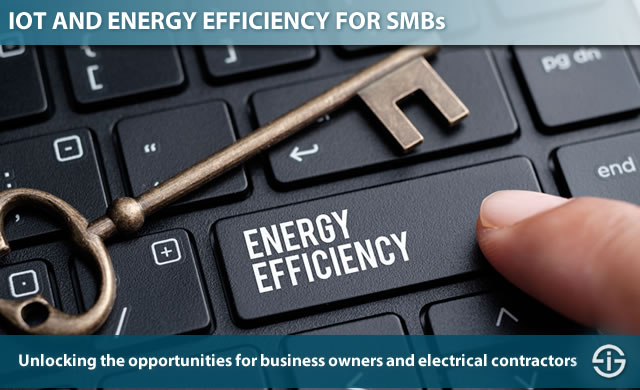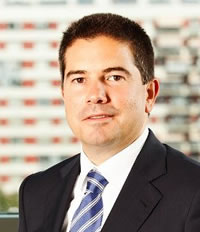Enrique Birlanga explains how smart panels, the Internet of Things and cloud computing help electrical contractors and owners of smaller to medium buildings become more efficient.
Electrical contractors come in all sizes and shapes, depending on the type of companies they serve and a potential focus on specific sectors.
Yet, regardless of their core markets, electrical contractors share quite some similar challenges and opportunities. The Internet of Things (IoT), smart sensors, and connected energy solutions have certainly added to these opportunities as you can read in this article.
IoT enables electrical contractors to go beyond the design, install and go approach
Smaller contractors who work with small to medium businesses such as restaurants, offices, industries, smaller retail chains and branch offices, to name a few, typically operate in a highly competitive and price-sensitive market with electrical solutions in an increasingly commoditized low voltage (LV) environment. It’s a rather traditional business of “design, install and go” as Enrique Birlanga, who is responsible for the Connected Power certification badge of the Schneider Electric EcoXpert partner program, puts it.

The challenges and opportunities for electrical contractors in an IoT ‘connected power’ reality
While there is certainly work enough for electrical contractors and energy experts overall, the business model of the contractor is increasingly challenged.
Moreover, with the Internet of Things they have opportunities to deliver new, value-added services to customers with higher margins, competitive benefits and a closer relationship to their typical SMB customers than in an ‘install and go’ scenario. These additional services are also in higher demand, not in the least due to cost saving, energy efficiency and monitoring/maintenance demands.
However, this requires electrical contractors to take some steps in areas they are less used to: on top of skill sets with regards to electricity, they need skill sets with regards to essential IT and IoT know-how.
And that does require seeing the benefits, a culture of growth and innovation and an openness towards digitization and digital transformation and, most certainly, changing customer needs.
That’s exactly what Schneider Electric does with the ‘Connected Power’ badge within the EcoXpert partner program: help electrical contractors tap into the clear benefits by training them in acquiring these skillsets and, at least as important, understand the existing connected power solutions such as smart panels, smart metering and the energy management and efficiency systems in the cloud, which make all the difference from the contractor, customer and optimization and services perspective.
If you look at connected energy in general, there is a clear move towards energy efficiency and consumption across all kinds of buildings, not just the larger commercial ones. It also occurs in small and medium enterprises, just as it even does in residential homes.
In June 2017 IoT investment forecasts, IDC puts smart grids (electricity) and smart buildings among the top IoT use cases in smart industry. It’s a well-known fact that smart buildings de facto mainly revolves around energy management. and connected power for energy efficiency.
This isn’t any different in Small and Medium Business. By definition, this means that the traditional electricity partners of SMBs, the electrical contractors, are poised to face disruption as the demand for energy consumption reduction, maintenance and monitoring goes up due to a variety of reasons.
Small and medium business owners want to leverage IoT for energy efficiency
On top of regulatory demands these reasons include the common business sense of owners of restaurants, small fast-food chains, retail stores and branch offices, which are some types of the small and medium end customers that are served by Connected Power EcoXpert partners as Enrique states.
Connected power solutions result in 15% savings on energy consumption for SMBs
It’s a known fact that approximately 40 percent of energy consumption is due to buildings. Yet, not all buildings are the same: while we often look at large energy consumers such as manufacturing plants, to cite one, family homes and certainly the mentioned end customers of EcoXpert certified electrical contractors, which are massively present across the globe, add to it in a significant way as well.
One could call it the ‘long tail of energy consumption’. Look at all the electricity and energy consumption going on in restaurants and fast food chains: fridges, freezers, ovens, lighting, potentially climate control, loads of kitchen equipment, the list goes on.
However, it isn’t just about saving costs and getting a better grip on energy consumption and energy efficiency through intelligent solutions. It’s also about cost avoidance, including indirect costs.
As an example: think about restaurants and fast-food chains again. The consequences of a power outage at night, without anyone knowing about it as there is no connected power solution to give an alert, can be quite dramatic for business owners. It’s clear that the last thing you want as a restaurant owner is that all the food in your fridges needs to be thrown away.
This doesn’t just cause immediate costs but also business disruption as the next day(s) you might need to spend quite some time cleaning and buying new food again – and maybe even have to close your doors to your customers, missing potential revenues. In other words: it’s also about business continuity and, not to be underestimated, peace of mind with regards to uptime and maintenance.
The impact of a power outage can be dramatic for small business owners
Whether we like it or not: ‘smart electricity’ and intelligent energy efficiency, leveraging data and connected components, is the future, also for smaller organizations.The more connected everything gets (and it will), the easier, smarter and user-friendly the solutions become and the more mainstream IoT technology is, the more interrupted all players in traditional markets become.
For electrical contractors, the challenges are clear. However, often the benefits aren’t understood well enough. Just consider this though: on average, connected power solutions result in a benefit of 15 percent savings on energy consumption. Demonstrating the ROI (Return On Investment) to end customers of these solutions is one of the things contractors can learn in the EcoXpert Connected Power certification.
The choices for electrical contractors are relatively straightforward: do they want to remain in a very competitive and commoditized market with high cost pressure, low margins and no-repeat business while the uptake of smart panels and smart energy efficiency solutions goes on and in the end makes them less relevant or do they want to become leaders instead of laggards, tapping into new revenue sources with high margins (services, consulting,…) and up-sell and cross-sell opportunities as they stay longer and close to customers, up the value chain?
The solutions, benefits, programs and certification paths are there, now it’s just a matter of acting.
Read next: Critical power realities and evolutions in critical power buildings
Disclaimer: we deliver services to Schneider Electric’s EcoXpert program, including content services. Top image: Shutterstock – Copyright: kenary820


